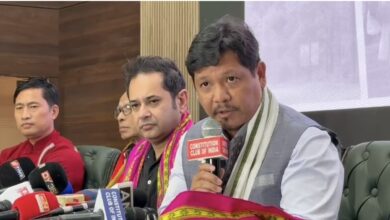Breaking stereotypes: Girls in coding, AI, robotics & trades
International Day of the Girl Child on Oct 11: Why skilling the girl child could be India’s biggest leap toward an inclusive innovation economy

 We frequently discuss India’s growth story; we speak about technology, innovation and the youth propelling it. But when we observe deeper, something important is missing. Our girls, who make up half of this young population, are still not equally represented in the very sphere that is shaping the future: coding, artificial intelligence, robotics, and skilled trades.
We frequently discuss India’s growth story; we speak about technology, innovation and the youth propelling it. But when we observe deeper, something important is missing. Our girls, who make up half of this young population, are still not equally represented in the very sphere that is shaping the future: coding, artificial intelligence, robotics, and skilled trades.
India is brimming with progressive young women who are curious, determined and competent. What they often lack is not talent but the right exposure and upliftment to explore unorthodox career paths.
For many decades, we have inadvertently, or maybe deliberately, been telling girls that certain jobs are “not for them”. Coding is for boys. Welding is for men. Robotics, electronics, or mechanical work sound too technical, too tough. These labels have quietly limited opportunities for millions of young women.
The truth is, when we close doors for girls, we close doors on innovation itself.
Gender gap in skills
Globally, women make up less than one-third of the workforce in technologically forward fields. In India, the figure is even lower when it comes to technical and vocational streams. Only a handful of girls choose IT, electronics or mechanical trade courses, and even fewer pursue a career in those fields. The CII Technology Report, 2024, states that around 14% of India’s STEM jobs are held by women, and female researchers account for less than one in five scientists in R&D institutions.
At premier institutions like the IITs, female enrolment has stagnated at around 20 %, even after supernumerary seats were introduced in 2018, says a Times of India report. Even as digital transformation reshapes every industry, women remain underrepresented in the very fields defining the future.
This is not because they are not able to do it. As a matter of fact, Indian girls always excel in school-level examinations compared to boys. The problem is elsewhere, in inaccessibility, invisibility, and an attitude that continues to equate technical labour with men.
Many girls in rural or small-town India have never stepped into a lab or seen a coding class in school. Being deprived of early exposure or role models that resemble them makes them less likely to visualise themselves in those positions.
Skills as the great equaliser
If India wants to build a truly inclusive economy, the answer lies in skills. Skill-based education is a great equaliser. It does not reward degrees or background but hard work, inquisitiveness, and problem-solving skills.
Something changes inside a young student after she builds her first robot or creates her first application. The question of what more she can do replaces the one of whether she can do it. This is the power of exposure and practical learning.
The National Education Policy (NEP) 2020 and the National Credit Framework (NCrF) are some significant steps in this direction. They stimulate schools and higher education institutions to combine academic learning with work-integrated learning. In the case of girls, it will allow them to pursue not only other traditional subjects but also coding and electronics or design and discover their strengths at an early age.
Technology is gender-neutral; opportunity should be too
Technology does not discriminate based on gender. Skill is answered by algorithms, machines and robots, not stereotypes. What is important is who has the opportunity to learn, experiment and create.
When girls learn AI or robotics, they do more than gain employability. They introduce a fresh breath to the design and use of technology. A diverse technical state of affairs develops more equal systems, smarter tools, and solutions that benefit everyone.
The same goes for trades. The modern electrician or plumber works with sensors, AI-based tools, and advanced systems. These are not jobs of brute strength but of technical intelligence, attention to detail, and precision. Women can excel here just as much as men.
Successful and optimal implementation of initiatives like Vigyan Jyoti Scheme, the WISE-KIRAN (Knowledge Involvement in Research Advancement through Nurturing) Scheme, the Women Scientist Scheme (WOS), and the CURIE (Consolidation of University Research for Innovation and Excellence in Women Universities) Programme can create pathways for women to re-enter, thrive, and lead in STEM related workspaces, research and innovation.
Changing the mindset
Change should begin from the classrooms, workshops, and most importantly, home. Educationalists must see potential, rather than marks. They are supposed to motivate girls to attempt, fail and attempt again using machines, codes or circuits until excellence is achieved.
The role of parents and communities is also necessary. When a neighbouring shop employs a woman technician, or a rural schoolteacher brings the subject of coding to girls, it sends the message that such places are open to all. It begins with a little change, but the effects span over generations.
Industry partnerships that open doors
The education ecosystem cannot do this alone. Industry must come forward as an equal partner. Companies in AI, automation, manufacturing and robotics should step out as an equal partner.
The companies in AI, automation, manufacturing and robotics can contribute to it through the trading of mentorships, internships, and on-site training, which will actively incorporate women.
Such partnerships do not just create jobs. They help girls see where learning leads. A student who spends a few months at a robotics lab learns more than any classroom could offer. She sees her skills come alive.
The industrial participation also assists in making sure that whatever is taught in universities remains relevant to what employers require. This orientation would render skilling more meaningful and future-oriented.
Taking skills to rural India
India’s growth will only be complete when opportunities reach beyond big cities. Around 68% of Indian youth live in small towns and villages, yet most skill-based programmes and tech education hubs are still urban. Rural girls face the toughest challenges, including limited education, very few facilities, and stronger social standards.
Mobile skill labs, community training centres, and online learning platforms can change this reality. With localised trainers and flexible courses, rural girls can now learn robotics, digital design, or electrical work without leaving home. When opportunities reach them where they are, the results can be transformative.
More than jobs: Confidence and identity
The impact of skilling girls goes beyond getting them jobs. It builds confidence and identity. A girl who can repair an engine or write code stands taller. She earns respect at home and in her community.
Skills bring independence, the kind that allows women to make choices, support families, and become role models. Every time a woman steps into a field once considered male-only, she paves the way for others to follow.
Skill-based education also celebrates the dignity of work. Whether someone is building software or fixing solar panels, both contribute equally to India’s growth story.
The way forward
With more young women now making up 43% of enrolments in STEMM disciplines (PIB, 2024), India stands at the cusp of a quiet revolution—one where classrooms today will shape boardrooms, laboratories, and startups tomorrow. This growing participation signals a future where women are not just part of the workforce but leaders redefining India’s scientific and industrial landscape, driving true gender parity in employment.
The coming decade will decide how well India can convert its demographic advantage into a skills advantage. Girls must be at the centre of that journey. This is not just about equality but about tapping into the full potential of our population.
When girls learn to code, design, build, or repair, they bring fresh ideas and empathy to innovation. They do not just prepare for the future; they help shape it.
If we can give every girl a fair chance to learn the skills of tomorrow, we will not just bridge the gender gap; we will redefine what progress looks like for an Atmanirbhar Bharat.
Banner image by Tara Winstead: https://www.pexels.com/photo/hand-with-silver-glove-holding-a-robot-hand-8849283/




